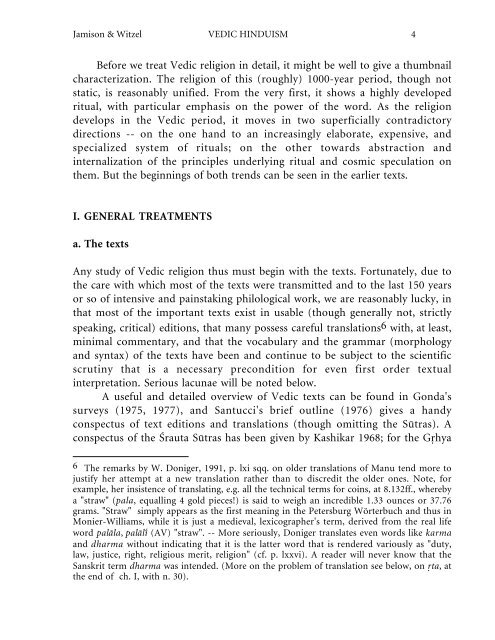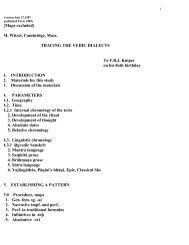VEDIC HINDUISM by S. W. Jamison and M. Witzel - people.fas ...
VEDIC HINDUISM by S. W. Jamison and M. Witzel - people.fas ...
VEDIC HINDUISM by S. W. Jamison and M. Witzel - people.fas ...
Create successful ePaper yourself
Turn your PDF publications into a flip-book with our unique Google optimized e-Paper software.
<strong>Jamison</strong> & <strong>Witzel</strong> <strong>VEDIC</strong> <strong>HINDUISM</strong> 4<br />
Before we treat Vedic religion in detail, it might be well to give a thumbnail<br />
characterization. The religion of this (roughly) 1000-year period, though not<br />
static, is reasonably unified. From the very first, it shows a highly developed<br />
ritual, with particular emphasis on the power of the word. As the religion<br />
develops in the Vedic period, it moves in two superficially contradictory<br />
directions -- on the one h<strong>and</strong> to an increasingly elaborate, expensive, <strong>and</strong><br />
specialized system of rituals; on the other towards abstraction <strong>and</strong><br />
internalization of the principles underlying ritual <strong>and</strong> cosmic speculation on<br />
them. But the beginnings of both trends can be seen in the earlier texts.<br />
I. GENERAL TREATMENTS<br />
a. The texts<br />
Any study of Vedic religion thus must begin with the texts. Fortunately, due to<br />
the care with which most of the texts were transmitted <strong>and</strong> to the last 150 years<br />
or so of intensive <strong>and</strong> painstaking philological work, we are reasonably lucky, in<br />
that most of the important texts exist in usable (though generally not, strictly<br />
speaking, critical) editions, that many possess careful translations6 with, at least,<br />
minimal commentary, <strong>and</strong> that the vocabulary <strong>and</strong> the grammar (morphology<br />
<strong>and</strong> syntax) of the texts have been <strong>and</strong> continue to be subject to the scientific<br />
scrutiny that is a necessary precondition for even first order textual<br />
interpretation. Serious lacunae will be noted below.<br />
A useful <strong>and</strong> detailed overview of Vedic texts can be found in Gonda's<br />
surveys (1975, 1977), <strong>and</strong> Santucci's brief outline (1976) gives a h<strong>and</strong>y<br />
conspectus of text editions <strong>and</strong> translations (though omitting the Sūtras). A<br />
conspectus of the Śrauta Sūtras has been given <strong>by</strong> Kashikar 1968; for the G�hya<br />
6 The remarks <strong>by</strong> W. Doniger, 1991, p. lxi sqq. on older translations of Manu tend more to<br />
justify her attempt at a new translation rather than to discredit the older ones. Note, for<br />
example, her insistence of translating, e.g. all the technical terms for coins, at 8.132ff., where<strong>by</strong><br />
a "straw" (pala, equalling 4 gold pieces!) is said to weigh an incredible 1.33 ounces or 37.76<br />
grams. "Straw" simply appears as the first meaning in the Petersburg Wörterbuch <strong>and</strong> thus in<br />
Monier-Williams, while it is just a medieval, lexicographer's term, derived from the real life<br />
word palåla, palål� (AV) "straw". -- More seriously, Doniger translates even words like karma<br />
<strong>and</strong> dharma without indicating that it is the latter word that is rendered variously as "duty,<br />
law, justice, right, religious merit, religion" (cf. p. lxxvi). A reader will never know that the<br />
Sanskrit term dharma was intended. (More on the problem of translation see below, on �ta, at<br />
the end of ch. I, with n. 30).

















